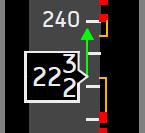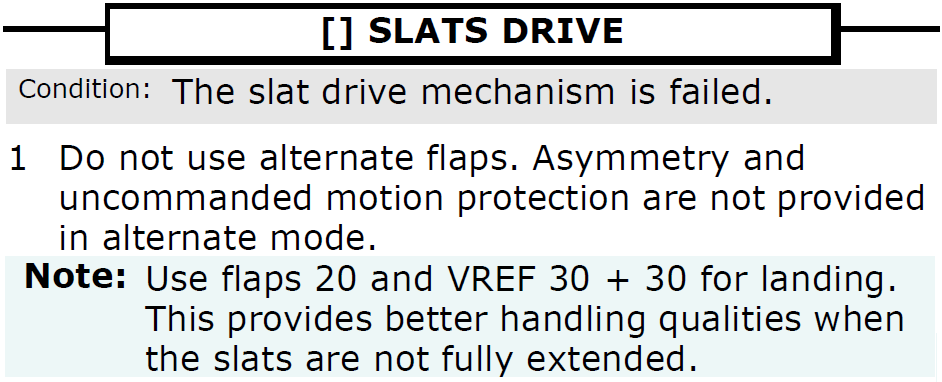The Slats (as opposed to Flaps) are high lift, leading edge devices designed to increase the lift on a wing that’s designed for high speed / high altitude flight, not this low speed lifting 350 tons off the ground manoeuvre that we insist on performing at the beginning of every flight.
Sometimes they fail and one of the possible failures is a [] SLATS DRIVE message that leaves them stuck in the current position. At heavy weights, retraction of Flaps after a [] SLATS DRIVE on a heavy weight takeoff gets tricky …
Procedures & Techniques : Slats Drive Go-Around
Slats Drive go-around has been shown in the simulator to have unusual flight characteristics. Boeing have confirmed that the simulator is following the same control law as the aircraft, and as such crew should expect the aircraft to behave the same way.
Essentially during a go around after a Slats Drive failure, the AFDS increases pitch rate slowly to a target of about 8-10 while airspeed continues to accelerate through the flap limit speed. The solution is to either disconnect and fly manually, or potentially a reversion to FLCH will restore correct AFDS speed/pitch behaviour.
Engine out Slats Drive Go-Around has the same pitch problem, although the result is less marked owing to reduced performance. Note that the use of FLCH to recover will reduce the thrust limit setting to the CLB/CON limit prematurely, and may compromise go around acceleration/performance.
Procedures & Techniques : Slats Drive & Flap Retraction
 When a [] SLATS DRIVE failure occurs during takeoff – particularly at heavy weight – crew need to carefully consider continued flap retraction as an increasing minimum manoeuvre/stick shaker can combine with the flap/slat limit speed to leave the crew with no room to manoeuvre. Either AIRSPEED LOW or Flap Limit speed exceedences are likely. In a clash, the AFDS will exceed the flap limit speed, rather than fly a speed below minimum manoeuvre speed.
When a [] SLATS DRIVE failure occurs during takeoff – particularly at heavy weight – crew need to carefully consider continued flap retraction as an increasing minimum manoeuvre/stick shaker can combine with the flap/slat limit speed to leave the crew with no room to manoeuvre. Either AIRSPEED LOW or Flap Limit speed exceedences are likely. In a clash, the AFDS will exceed the flap limit speed, rather than fly a speed below minimum manoeuvre speed.
Procedures & Techniques : Slats Drive – Do We Extend the Flaps?
There is occasionally some confusion on the flight deck associated with the [] SLATS DRIVE NNM. A Slats Drive failure leaves the Slats unavailable to the crew. While not necessarily mechanically correct – you can think of this failure as the detection of an asymmetric Slat extension and therefore the FSEU has shut down the affected system to preclude further asymmetric control surface deployment. This is one reason why Alternate Flaps – which overrides the FSEU for both Flaps and Slats – is specifically forbidden.
Having been told they must not use Alternate Flap extension, Crew are sometimes reticent to extend Flaps (not the Slats) through the normal Flap lever. However, a visual review on the PFD of the nominated QRH NNM approach speed (Vref 30+30) confirms the need for additional flap extension for landing. The checklist also says “Use Flaps 20 and … for landing.”

Ken.
If you find my content useful and are in a position to do so – I would appreciate a contribution to my PayPal account (ken.pascoe@gmail.com) – If you use the Friends and Family feature in PayPal it reduces the charges to the transfer. Please note that when sending money in this way you are removing any form of purchase protection, which is not relevant to a contribution of this type anyway.
